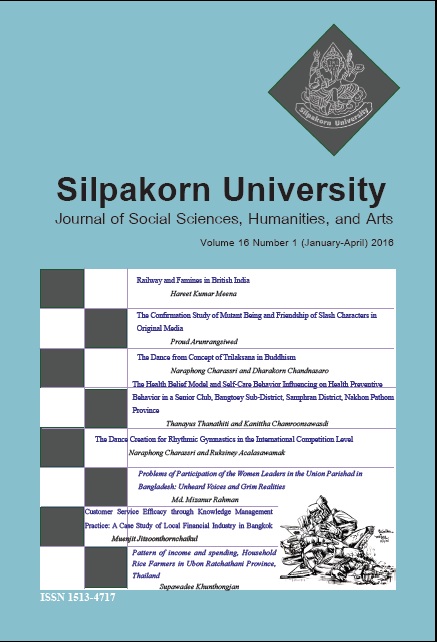Customer Service Efficacy through Knowledge Management Practice: A Case Study of Local Financial Industry in Bangkok
Main Article Content
Abstract
This research is carried out to study the major six dimensions of knowledge management practice that may affect the quality of customer service on frontline employee’s performances used qualitative method, in-depth interview to analyze information from management level
(department level above) and questionnaire reviews methods to confirm the quantitative results. Six dimensions of knowledge management consist of knowledge acquisition, knowledge creation, knowledge storage, knowledge analysis, knowledge transferring, and knowledge utilization. The research results show that the frontline employees have applied the six dimensions of KM to their customers and they do recognize the important of services in respectively. The research results also point that six dimensions of KM and gender of service providers have affected organization in improving the quality of customer service. As the results of this research, it may conclude that KM practice can retain loyalty customer and expand new customer sustainability.
Downloads
Article Details
All rights reserved. Apart from citations for the purposes of research, private study, or criticism and review,no part of this publication may be reproduced, stored or transmitted in any other form without prior written permission by the publisher.
References
Argote, L. (2000) Knowledge Transfer in Organizations: Learning from the Experience of Others. Organizational Behavior and Human Decision processes 82(1): 1-8.
Backer, T. E. (2001) Utilization: The Challenge of Transferring Innovations in Rehabilitation and Special Education. Washington, D. C.: National Rehabilitation Information Center.
Beesley, L. and Cooper, C. (2004) Multi-Level Complexity in the Management of Knowledge Networks. Journal of Knowledge 8(3): 71-100.
Bukowitz, W. and Williams, R. (1999) Culture. Mapping,Technology, and Measure. In The Knowledge Management Fieldbook. New Jersey: Prentice Hall.
Carey, G. (1998) Multivariate Analysis of Variance (MANOVA) II: Practical Guide to ANOVA and MANOVA for SAS [Online URL:https://ibgwww.colorado.edu/~carey/p7291dir/handouts/manova2.pdf] accessed October 18, 2014.
Creswell, J. W. and Plano Clark, V. L. (2011) Design and Conducting Mixed MethodsResearch. California: SAGE Publication, Inc.
Davenport, T. H. and Beck, J. C. (2002) The Strategy and Structure If Firms in the Attention Economy. Ivey Business Journal 66(4): 48-54.
Davenport, T. H. and Prusak, L. (2007) Working Knowledge: How Organizations Manage What They Know. Cambridge, MA: Harvard Business School Press.
Greene, J. C. and Caracelli, V. J. (1997) Advances in Mixed-Method Evaluation: The Challenge and Benefits of Integrating Diverse Paradigms. California: Jossey-Bass publications..
Greene, J. C., Caracelli, V. J. and Graham, W. F. (1989) Toward a Conceptual Framework for Mixed-Method Evaluation Designs.
Educated Evaluation and Policy Analysis 11(3): 255-274. Huber, G. P. (1991) Organizational Learning: The Contribution Processes
Invertopedia. (2015) Customer Service. [Online URL: https://www.investopedia.com/terms/c/customer-service.asp] accessed July 28, 2015.
Johnson, B., Onwuegbuzie, A. and Turner, L. (2007) Toward a Define of Mixed Methods Research. Journal of Mixed Methods Research 1(2): 112-133
Lynn, G. S., Morone, J. G. and Paulson, A. S. (2006) Marketing and Dissentious Innovation: The Probe and Learn Process. California Management Review 38(3): 8-37.
Lynn, G. S., Morone, J. G. and Paulson, A. S. (2006) Marketing and Dissentious Innovation: The Probe and Learn Process. California Management Review 38(3): 8-37.
Marakas, G. M. and Elam, J. J. (2007) Creativity Enhancement in Problem Solving through Software or Process? Management Science 43(8): 1136-1146.
Marquardt, M. (2001) Action Learning: A Powerful New Tool for Developing Individuals, Teams and Organizations. Transitions 9(2): 2-7
Marquardt, (2006) Building the Learning Organization. New York: Mc Graw Hill
McInerney, C. (2002) Knowledge Management and the Dynamics Nature of Knowledge. Journal of the American Society for information Science and Technology 53(12): 1009-18.
Nevis, E. C., Dibella, A. J. and Gound, J. M. (1995) Understanding Organizations as Learning Systems. Slon Management Review36 (Winter): 73-85.
Nonaka, I. and Takeuchi, H. (2005) The Knowledge Creating Company. New York: Oxford University press.
Phusuwan, Y. (2006) Knowledge Management. KM: Strategies&Tools: 13-14. [Online URL: accessed https://www.knowledgemanagement-strategy.html] accessed September 28, 2013.
Reference for business. (2015) Service Industry. [Online URL: https://www.referenceforbusiness.com/management/Sc-Str/Service-Industry.html#ixzz3Vko5DMnb] accessed March 29, 2015
Steward, T. A. (1998) Intellectual Capital: The New Wealth of Organizations. London: Nicholas Brealey Publishing.
Teece, D. (2001) The Market for Know-How and the Efficient International Transfer of Technology. The Annuals of the American Academic of Political and Social Science 458: 81-96.
Werr, A. and Stjemberg, T. (2003) Exploring Management Consulting Firms as Knowledge Systems. Organization Studies 24(6): 881-998.


